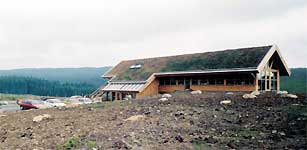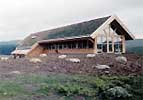Timber cladding in Scotland
The study outlines the development of timber cladding in Scotland, describes timber clad buildings in Scotland, and provides practical information on the use of timber cladding in Scotland.
Timber Cladding in Scotland
HOMEGROWN DOUGLAS FIR
CASE STUDY
RENEWABLE ENERGY OFFICE FOR NATURAL POWER, DALRY, DUMFRIES AND GALLOWAY
NEIL SUTHERLAND
|
The recent winner of the Association for the Protection of Rural Scotland's 'Creative, Native and Innovative' Award, Natural Power's new 20 person eco-office is a consummate exercise in the use of home-grown timbers. All of the wood employed - with the exception of a few pieces of Oak handrail obtained from mainland Europe - was sourced in Scotland, with around 60% of it coming from nearby woodland owned and managed by the client. Three softwood species (Norway spruce, European larch and Douglas fir) and two hardwood were selected for their practical characteristics. The softwoods were chosen from 45 year old stands of trees and the resulting 120 tonnes of logs were converted using a portable mill in the estate yard. The converted timber was stacked there and seasoned over the summer of 2000. A small quantity of Douglas fir (some 5 cubic metres) was kiln-dried locally for internal fit-out purposes. |
Exposed posts and trusses made from large section Douglas fir form the building's mortise and tenon jointed timber frame (with steel connectors and steel wire used for the tension members). The 25 x 150mm vertical cladding is formed from Douglas fir heartwood, with the same material used for soffits, barge-boards and fascias. Although homegrown Douglas fir is classed as being less durable than imported timber this is not seen as a problem in this case because the cladding is carefully detailed for drainage and ventilation and because it is painted with a water-repellent surface coating. The horizontal counterbattens behind the cladding are however made from European larch heartwood, chosen because water was likely to lie on them and because the support battens are more difficult to maintain than the outer cladding. The moisture-repellent coating used was transparent and so it is expected that this will have to be maintained every two years. It will also serve to slow down the rate at which the timber surface weathers to grey although it will not prevent it eventually occurring.
Apart from its use as counterbattens, European larch was used for sole plates, with the less durable Norway spruce utilised for all secondary purlins, floor joists and framing. No timber preservative was used anywhere on the building. The external balcony is constructed from green oak because of its particular exposure to the Dumfries and Galloway climate. Internally, the staircase was fabricated locally from oak and sycamore, with Scottish sycamore also used for the upper floor and associated finishes.

Neil Sutherland
Contact
Email: Central Enquiries Unit ceu@gov.scot
There is a problem
Thanks for your feedback
